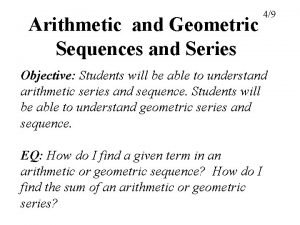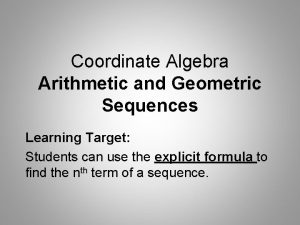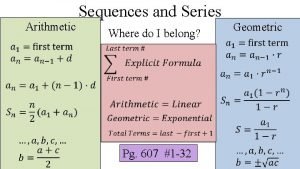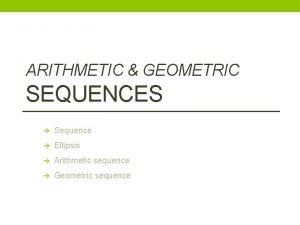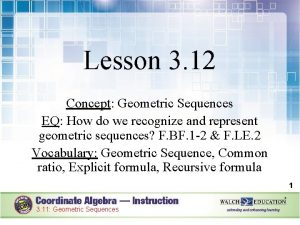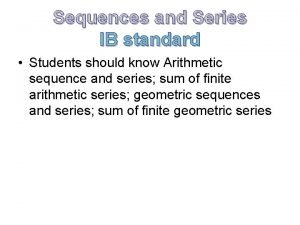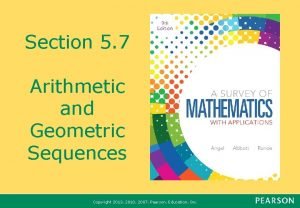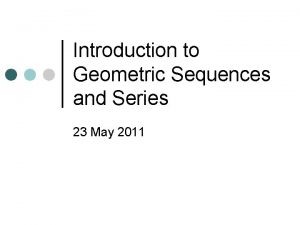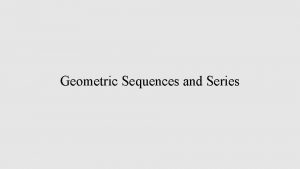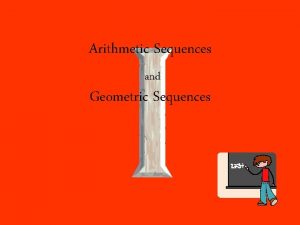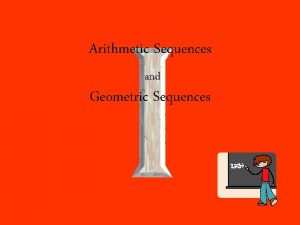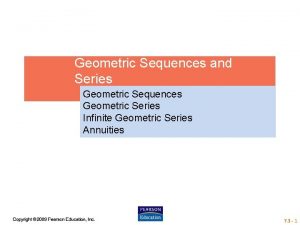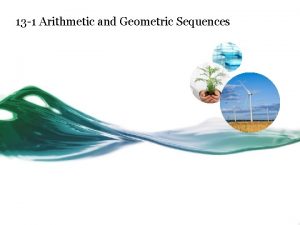ARITHMETIC AND GEOMETRIC SEQUENCES SEQUE NCES LESSO N








- Slides: 8

ARITHMETIC AND GEOMETRIC SEQUENCES SEQUE NCES: LESSO N 2

TYPES OF SEQUENCES: ARITHMETIC SEQUENCE In an Arithmetic Sequence the difference between one term and the next term is a constant. Each term is found by adding some constant value each time always think add, add a positive or add a negative (not subtract) The common difference (d) is the constant number you add each time and is usually represented by the variable d For example, Describe: 1, 4, 7, 10, 13, 16, 19, 22, 25, … 1. 5, . 75, 0, -. 75, -1. 5, -2. 25, … (you are adding 3 each time) (you are adding -. 75 each time) Arithmetic sequence common difference of 3 or d=3 common difference of -. 75 or d=-

ARITHMETIC SEQUENCE For each sequence, determine if it is arithmetic, and find the common difference. 1. -3, -6, -9, -12, … 1. Arithmetic, d = -3 2. 1. 1, 2. 2, 3. 3, 4. 4, … 2. Arithmetic, d = 1. 1 3. 41, 32, 23, 14, 5, … 3. Arithmetic, d = -9 4. 1, 2, 4, 8, 16, 32, … 4. Not an arithmetic sequence.

TYPES OF SEQUENCES: GEOMETRIC SEQUENCE In a Geometric Sequence the ratio between one term and the next term is a constant Each term is found by multiplying the pervious term by a constant. always think multiply, multiply by an integer or by a fraction (not divide) The common ratio (r) is the constant number you multiply by each time and is usually represented by the variable r For example, Describe: 2, 4, 8, 16, 32, 64, 128, … (you are multiplying by 2) Geometric sequence Common ratio of 2 or r=2 27, 9, 3, 1, 1/3, 1/9, 1/27 , … (you are multiplying by 1/3 ) Geometric sequence Common ratio of 1/3 or r= 1/3

GEOMETRIC SEQUENCE For each sequence, determine if it is geometric, and find the common ratio. 1. 2, 8, 32, 128, … 1. Geometric, r = 4 2. 1, 100, 1000, … 2. Geometric, r = 10 3. 1, -1, … 3. Geometric, r = -1 4. 20, 16, 12, 8, 4, … 4. Not a geometric sequence.

WRITE A SEQUENCE / FIND A TERM To write terms of a sequence or find a term: plug in the term number, n, as input, and evaluate to find the term, an, as an output. (it’s just a function!) Example 1: Example 2: A sequence generated by the formula The rule is: an = 6 n – 4. an = 3 n + 1 Generate the first 5 terms of the sequence. a 1 = 6(1) – 4 = 2 Find a 100 a 2 = 6(2) – 4 = 8 a 3 = 6(3) – 4 = 14 a 100 = 3(100) + 1 a 4 = 6(4) – 4 = 20 a 5 = 6(5) – 4 = 26 a = 301 2, 8, 14, 20, 26 100

WRITE A SEQUENCE / FIND A TERM To write terms of a sequence or find a term: plug in the term number, n, as input, and evaluate to find the term, an, as an output. (it’s just a function!) Example 3: Example 4: A sequence generated by the formula A sequence generated by the an = 5 + 2(n – 1). formula Generate the first 5 terms of the sequence. xn = 2(n – 1) a 1 = 5 + 2((1) – 1) = 5 List the first 5 terms. = 2(0) = 1 a 2 = 5 + 2((2) – 1) = 7 x 1 = 2((1) – 1) = 2(1) = 2 a 3 = 5 + 2((3) – 1) = 9 x 2 = 2((2) – 1) = 2(2) = 4 a 4 = 5 + 2((4) – 1) = 11 x 3 = 2((3) – 1) = 2(3) = 8 a 5 = 5 + 2((5) – 1) = 13 x = 2((4) – 1) = 2(4) = 16 5, 7, 9, 11, 13 4 ((5) – 1) x 1, = 2 2, 4, 8, 5 16

SEQUENCES AS FUNCTIONS • Remember a sequence is a function • ALL ARITHMETIC SEQUENCES ARE LINEAR FUNCTIONS because they have a constant rate of change (the common difference) • Geometric Sequences are other types of functions they often are exponential, but can be other kinds of functions as well
